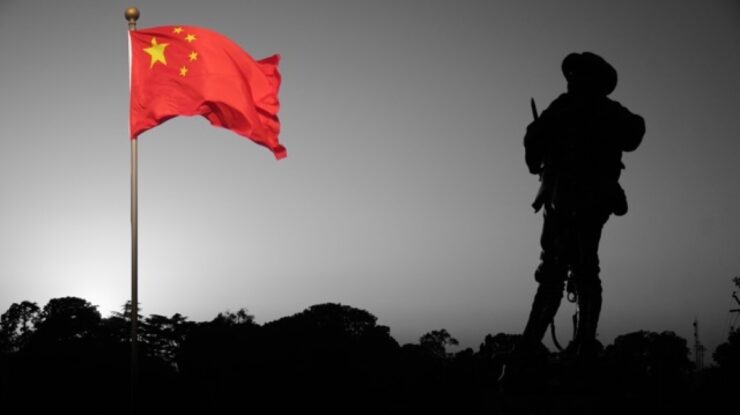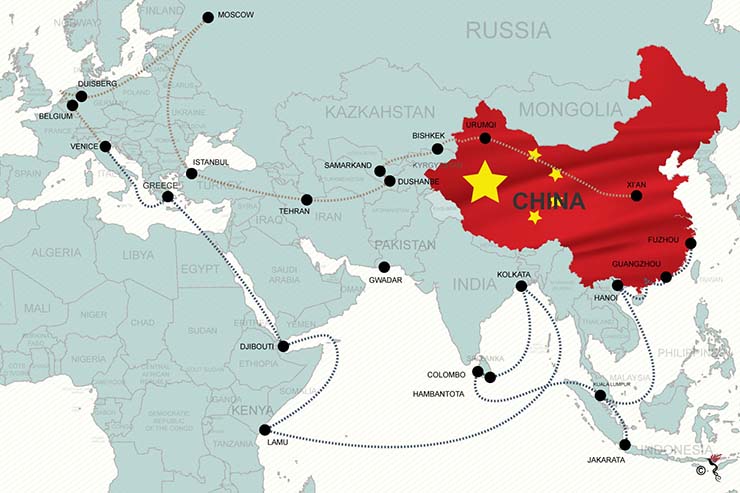
“Never interrupt your enemy when he is making a mistake”, said Napoleon Bonaparte, the great French military leader and statesman. The idea of the Indo-Pacific is in vogue now, with almost every great power, ranging from the United States of America to China to India to France, talking about and carrying out various activities in the region. The Indo-Pacific, to begin with, is a geopolitical and bio-geographic construct comprising the waters of the Indian Ocean and the western and central Pacific; it extends right up to the strategic waterways of Indonesia. It is currently the most important and most contested geopolitical and geo-economic maritime zone in the world.
Importance Of the Region
The Indo-Pacific comprises over 60% of global humanity, as well as over 52% of global GDP and 46% of merchandise trade. In this context one must understand that the region is not the sole domain of any one country. A plethora of nation-states are trying to dominate the Indo-Pacific region. The idea of the Indo-Pacific was proposed sometime around the 2004 Tsunami. The navies of Australia, Japan, the USA, and India, collaborated to undertake rescue and disaster prevention measures in the aftermath of the devastation caused by the colossal tsunami.
Surrounding the idea of the Indo-Pacific is the much-talked-about Quad or Quadrilateral Security Dialogue. Quad is an informal grouping of countries that was first formed in 2007 when Japan, India, Australia, and the USA came together to carry out one of the most prolific military exercises of that year – Exercise Malabar. The idea of the Quad was the brainchild of the ex-Japanese premier Shinzo Abe. However, to avoid antagonizing China, the leaders of those nations did not go forward with their plan for well over a decade.
Nature of Chinese Encroachment
In the last few years, at least from 2015 onward, China has shown extreme hegemonistic tendencies in the Indo-Pacific region. China is the world’s second-largest economy – which is clearly a force to reckon with. Lately, under the totalitarian leadership of its president Xi Jinping, China has continuously demonstrated irredentist claims over one of the world’s most important water bodies- the South China Sea. Beijing lays claim to almost the whole of the sea for itself and has tried to exercise hegemony over the region. This has caused Beijing to get locked in confrontationist and sometimes violent territorial conflicts with its neighbours like Vietnam, Philippines, Indonesia, etc.
Though the Indo-Pacific region is different, China is operating with the same modus operandi in the Indo-Pacific. It is challenging the right of the other nations to freedom of navigation and the right to use its naval resources in that region. In the Indo-Pacific, China’s primary focus has been on the Indian Ocean Region, where the dragon wants to secure not only its energy supplies and trade routes, but also wants to become the pre-eminent power. China’s highly relevant military doctrinal text, “The Science of Military Strategy”, has emphasized the need to follow a “unified two oceans region” comprising the western Pacific and northern Indian Oceans. It mandates China to establish a permanent presence to not only extract their resources but also to influence the countries along their coasts. Additionally, they want to develop offensive and defensive military capabilities for those purposes.
The dragon has displayed greater ambitions over the seas following its vision of reviving the maritime silk route and realising the ‘middle kingdom’ dream. China has chosen the Indo-Pacific for its strategic objectives and has of late tremendously increased its naval power. The commissioning of its third aircraft carrier, Fujian, is noteworthy in this regard.
Quad is the Answer
It seems as if it is impossible to stop the dragon’s expansionist aims, but the China challenge is not unsurmountable. The answer lies in the word called Quad. The Quad group of countries is no doubt serious this time about curbing Beijing’s maritime belligerence. The Quad is a like-minded group of democracies that have developed a consensus on issues of economic, commercial, and strategic issues. As such, it would be naive to underestimate the power of this grouping.

The Quad is now playing a highly influential role in containing the influence of China in the Indo-Pacific region. Australia, Japan, and India have signed the Resilient Supply Chain Initiative (RSCI). The RSCI aims to develop alternate supply chains to reduce the rest of the world’s dependence on Beijing’s supply chains, especially with regard to semiconductors, vaccines, and raw materials. This dependence had affected almost every country adversely during the Covid- 19 pandemic. They also have taken the decision to jointly develop vaccines and disseminate them to the LDCs (Less Developed Countries) at the Quad summit held in Washington DC last year.
A significant initiative proposed at the recently concluded Quad summit in Tokyo some months ago, was to launch the Indo-Pacific Economic Framework (IPEF). This group is comprised of about 12 countries representing over 40% of the world’s population and 57% of the global GDP. Several foreign policy strategists and diplomats argue that it is nothing but an opposition to the ambitious and audacious Regional Comprehensive Economic Partnership (RCEP). The RCEP is billed as the most significant free trade agreement globally. The RCEP, combined with the Belt and Road Initiative (BRI), is expected to strengthen Beijing’s economic hold over the Indo-Pacific region.
Another possible step in the economic direction is to merge the Indo-Pacific Economic Framework (IPEF) with the Build Back a Better World (B3W) along the Global Gateway infrastructure initiatives. It is proposed that these be coalesced into a single monolithic infrastructure and economic initiative covering almost all countries of the world. This will be a befitting answer to China’s BRI that has become the cause of a major debt crisis in the world. especially in the aftermath of the Covid-19 pandemic.
But limiting the action to containing China in the economic domain won’t suffice. The real unassailable response to Chinese transgression and bellicose behaviour has to be military. China possesses the second largest army and the largest navy in the world. Additionally, the dragon is modernizing its armed forces by inducting cutting-edge, technology and weaponry, particularly in cyberspace and artificial intelligence. Notwithstanding the frightening might of the Chinese armed forces, the effective answer to the dragon’s intransigence is the Quad.
Developing a Coherent Strategy
The edge with regard to the Quad’s role in the Indo-Pacific domain is in the military arena. Without any doubt, the Quad countries possess the collective strength to take on the might of China. But it would require a carefully thought-out and proactive strategy.
The most potent response would be to develop what military strategists call defensive deterrence leverage. Defensive deterrence leverage has political and military aspects. Politically, it requires the Quad countries, particularly India, to align themselves closely to the littoral countries of the Indian Ocean in general and the Indo-Pacific region in particular. The Quad can achieve this by signing pacts and agreements in various sectors so as to withstand the shock of any regime change in any country in the region. The military dimension would require cultivating the strategy of interoperability of equipment among the Quad countries and if possible, bringing more countries under its ambit.
The strategy is already being implemented in phases; India has started using the P8I maritime reconnaissance aircraft of the USA as well as the Apache AH-60 attack choppers. India has also signed agreements with countries like Russia, Singapore, Indonesia, and Vietnam, to ensure smooth interoperability.
The second most crucial component of the military strategy is to initiate the process of deterrence denial. That can come by India and the other Quad countries bolstering their military strength; India can start increasing the range of its precision-guided missiles and fortifying its cyberspace abilities. Sophisticated platforms like nuclear missiles, aircraft carriers, and advanced fighter jet programs may take years and even decades to come to fruition; hence, this must be seen only as a short-term strategy. Also, the Quad countries can try the lend-lease system that the US had pioneered during the Second World War. Under this system, the Quad countries can utilize the necessary equipment during any skirmish in general and outright war in particular, by paying a certain fee.
Denial strategy articulates that since it is not possible for any one country in the Indo-Pacific region to stand up to the dragon, The Quad and other countries join forces to deter China from its use of strategic sea lanes at the critical time. This will help to not only thwart the arm-twisting tactics of China, but will also make the cost of invasion prohibitive for Beijing.
For this, there is a need to give the Quad the shape of a formal defensive military alliance.
The RCEP is billed as the most significant free trade agreement globally. The RCEP, combined with the Belt and Road Initiative (BRI), is expected to strengthen Beijing’s economic hold over the Indo-Pacific region
Undoubtedly, this will ruffle a lot of feathers in Beijing and among the advocates of pacifism in the Quad and Quad+ countries; but this is necessary. Moreover, to strengthen this alliance further, these countries could establish a similar partnership with NATO. It will not only contribute to the multiplication of forces but will allow NATO and Quad a common purpose- to contain China. Though of course, the Russian role in this entire equation is an unpredictable factor. However, I believe that there is enough room for diplomacy to help iron out the differences among the countries.
Conclusion
International politics is about competition between great powers; at least, that is what the realist school of thought argues – and rightly so. The Indo-Pacific region represents exactly that arena. However, at a time when multilateralism and plurilateralism are the accepted norms, it is clear that there is no room for hegemony, at least in the seas. Therefore, for the purpose of maintaining rules-based international order, the Quad countries must display higher and more visible commitment to containing the influence of China in the Indo-Pacific. The world cannot afford to go back to the cold war era period of international relations.
– The writer is currently working as a Research Associate at Defence Research and Studies (dras.in) and is a columnist. The views expressed are personal and do not necessarily reflect the views of Raksha Anirveda








